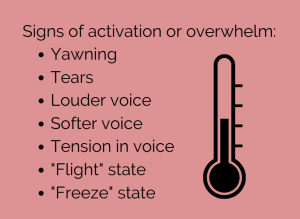3 Ways Somatic Therapy Can Help Dizziness
3 Ways Somatic Therapy can Help Dizziness
Learn how somatic therapy can help dizziness with psychotherapist Kate Schwab, LCSW. We’ll cover what somatic therapy is, the benefits, and tools to get started today.
Kate Schwab, LCSW is a licensed clinical social worker and psychotherapist. In vestibular group fit, Dr. Madison and Kate talk about how somatic therapy can help dizziness and tools that are helpful in supporting your body.
What is Somatic Therapy
Somatic therapy combines psychology, neuroscience, ethology, physiology, indigenous healing practices, and medical biophysics. Guidance of somatic therapists assist you in learning what your body needs to feel supported.
3 parts of somatic therapy involve:
- Nervous system activation and overwhelm
- Pacing
- Support tools
We’ll take a look at each of these parts to learn how somatic therapy can help dizziness. More information and a recorded interview with Madison and Kate can accessed with a premium account.
How is Somatic Therapy different than Acceptance and Commitment Therapy (ACT) or Cognitive Behavioral Therapy (CBT)?
ACT/CBT are talk therapies type and focus on behavior. Both are symptom management focus. ACT brings in more mindfulness work: what are your behaviors and beliefs and changing those. With somatic therapy, it’s less symptom oriented and more of ‘what’s happening for you internally?’. We are looking at WHY those symptoms are there and deeper work. These areas cover different parts, so if you’ve had ACT or CBT therapy, you could benefit from somatic therapy. Keep reading to learn how somatic therapy can help with dizziness in its unique way.
Who Could Benefit From Somatic Therapy?
Most people can benefit from this work, and there are many reasons we experience trauma responses. Chronic illness can be traumatic and so in general somatic work can be really useful!
Nervous System Activation and Overwhelm
When first experiencing pain or dizziness, we begin to try everything and anything to make it go away. This urgency can lead to desperation, feeling overwhelmed and hyper vigilant of what we’re experiencing. This heightened state ramps up our sympathetic nervous system- the “fight flight or freeze”. This is not a state we are meant to be in for long periods of time,and normally kicks in when there is an external threat. When the threat is external, like a sudden loud noise or dark looming figure, this is extremely helpful to get us out of that area and to safety. In the case of dizziness, the perceived threat is internal, so how do we get to safety? This is where somatic therapy can help.
This is so so common in dizziness, check out this article on the dizzy anxious cycle and Dr. Emily Kostelnik with Rooted Behavior Education for more on this as well.
Back to how somatic therapy can help with dizziness. Learning how our own body and nervous system begins to ramp up and “activate” helps us identify what our body needs to get through these situations and move towards health and homeostasis. Everyone is different, and each situation is different.

If we ignore these signs, or don’t have the tools to help support what our body is telling us, we can reach a point of overwhelm and our body shuts down on us. Pacing is the practice of identifying these activations, and working on tools to assist your body, a major part of what Kate and other somatic therapists are amazing at!
Pacing
Pacing involves going SLOW. This is not easy and takes practice. This makes us think about the exact moment we are in and what our body is experiencing. Go into a quiet room and focus on moving towards health. Focusing on what you’re feeling right now, what your body needs right now. This is abstract and hard, which is why lovely people like Kate are here to help guide you further. Pacing helps identify what you’re experiencing, and getting support systems in place. This is how somatic therapy can help with dizziness.
Over time and with practice, the goal is you start to learn more about your body and have tools to support it. Pacing helps you be more aware of your window of tolerance. It’s okay to have nervous system activation, people like Kate help you to identify and work through it. If you aren’t in touch with your body, it’s hard to move along various activation states tolerably.

Support Tools, Avoiding Hyperawareness, Derealization/Dissociation
It’s important to check in with your body with chronic conditions and symptoms to avoid doing too much, making it easy to become hyper vigilant of what you’re feeling.
Try and know that you know how to handle this, and you’ve filled your prescriptions, and you can call your doc if needed, you have a support system, and at the same time you need to let your brain set it down and enjoy the moment that you’re in. This is hard and takes repetition and practice.
What about derealization or dissociation?
These come with the feeling like you aren’t real. Like you’re watching your world through a TV. Feeling disconnected or viewing the world from a glass plane. These can be survival mechanisms (and that’s not a bad thing!) but ways to try to shake this are:
- Breathing (box breathing or 4 counts inhale, 8 counts exhale. Hold briefly before repeating)
- talking out loud to yourself “I’m okay I am present, I am here”
- can you put on a podcast to laugh at, music to sing or dance to?
Give these a try, did it help? These are a few of the ways somatic therapy can help dizziness, derealization and dissociation.
Contact info
Follow Kate for ongoing education or reach out if you have questions or are interested in working with Kate to see how somatic therapy can help dizziness, chronic pain and more! Click here to reach Kate’s website.

Want to learn more about tools, how somatic therapy can help dizziness, and other vestibular tools to get back to your daily life? Find out more at this link: https://thevertigodoctor.com/about-group/
Disclaimer:
Remember: this post is for informational purposes only and may not be the best fit for you and your personal situation. It shall not be construed as medical advice. The information and education provided here is not intended or implied to supplement or replace professional medical treatment, advice, and/or diagnosis. Always check with your own physician or medical professional before trying or implementing any information read here.
